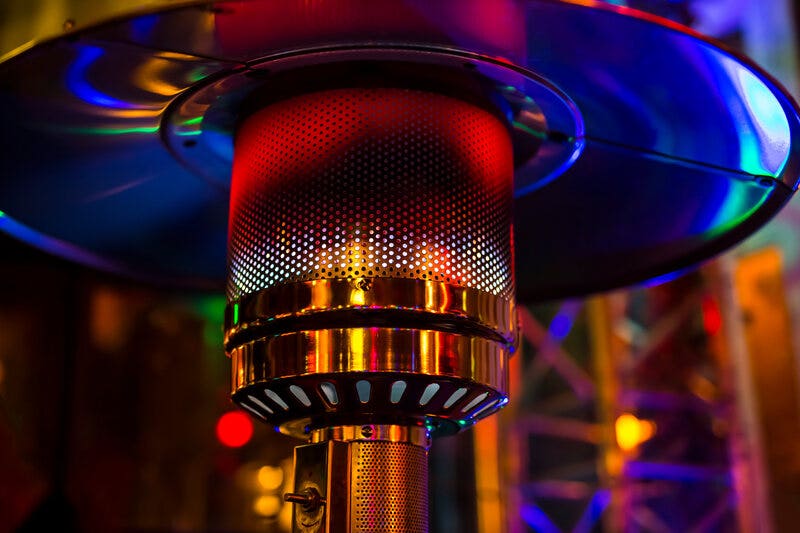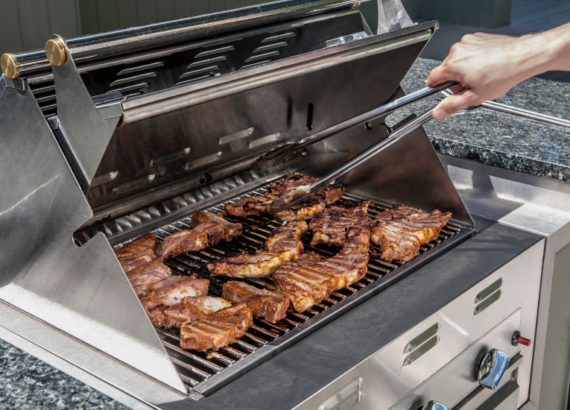Patio Heater Won’t Stay Lit? Here’s How To Fix It.

You want your patio heater to work efficiently for years to come. But at some point, your patio heater may stop working. Maybe it’s several years old or perhaps you’re new to patio heaters and are still learning how to maintain them properly.
If your patio heater won’t stay lit, there are many different ways you can troubleshoot it. We’ll go over 14 of them in this article.
Note: When troubleshooting your patio heater, wait five minutes for all surrounding gas to dissipate. After five minutes, you can safely ignite your heater.
Note: Consult the manufacturer’s instructions before troubleshooting any part of your patio heater.
**Who are we? For more than 20 years we have specialized in and sold thousands of range hoods to suit any kitchen or cooking style. Explore our hood types, including under-cabinet, wall-mount, island, outdoor, and insert range hoods.
Table of Contents
Make sure you aren’t running low on propane.
If you’re running out of propane, the pilot light on your patio heater won’t stay light for a long period of time. The flame will get weak and you’ll have to replace the tank.
Keep in mind that as temperature drops, the pressure in your propane tank decreases which reduces its efficiency. But this only becomes a problem in frigid temperatures several degrees below 0. At -44º F, propane turns into a liquid and won’t be able to provide heat.
Always have a backup propane tank so you don’t have to drop everything and get new propane when you run out.
Use pliers to move the thermocouple closer to the pilot light.
The thermocouple is a safety feature on your patio heater. It’s a metal device that detects heat coming from your patio heater. If the gas is on and the thermocouple doesn’t detect heat, it will turn off automatically.
But, if the thermocouple is too far away from the pilot light, it won’t detect heat and will shut off in error. If the pilot light is too close, the thermocouple will wear out quickly. The flame should come into contact with the thermocouple but not reach too high above it.
The thermocouple is typically under the lid of your patio heater. It will always be next to the heat source wherever that is on your heater.
When working with the electrical components of your patio heater, always turn it off first. Let the heater cool before troubleshooting it. Learn more about patio heater safety tips in this post.
Clean the thermocouple.
If soot and dirt accumulate on the thermocouple, it may not be able to detect heat properly and shut off unnecessarily. Even a little dirt on the thermocouple can cause a malfunction, so it’s important to keep it clean. Here’s how to do it.
- Detach the lid at the top of your patio heater. With most patio heaters, you can use a screwdriver.
- Remove any protective metal housing on the top of your patio heater to expose the thermocouple.
- Detach the thermocouple using a crescent wrench or screwdriver.
- Remove the soot and dirt using steel wool.
- Reattach the thermocouple and protective housing.
Check for insects or nests.
It’s possible for insects to make a home in or near the patio heater. Birds and other animals might make nests around the heater too. Not only is this a fire hazard, but it can also impact the strength of your flame.
Remove the nests or spray with insect repellent before using your patio heater. Make sure nothing is obstructing the flame.
Clean carbon deposits from the patio heater and its housing.

Over time, carbon will accumulate on your patio heater. Heavy buildup can cause a fire or obstruct the flame on your patio heater. Warm water and soap or a light non-abrasive cleaner work well to remove carbon deposits.
Reposition your patio heater to block the wind.
Slight winds can extinguish your pilot light or even tip your patio heater over. Move your patio heater to a corner or block the wind with some heavy furniture to keep the pilot light lit. It doesn’t take much wind to extinguish a pilot light – just a few miles per hour can cause problems.
Perform a leak test.
Gas leaks can cause your patio heater to malfunction. Fortunately, leak tests are pretty easy to do.
First, mix some dish soap and water. Brush it along the gas line and in areas that connect the propane tank or gas line to the heater. Turn on the gas and if you notice bubbles, there is a leak in that area.
Always do the leak test outdoors and make sure there are no open flames in the area. Here’s a quick video on how to do a quick leak test.
Tighten loose connections.
If you do find a leak, the easiest first step to resolve it is to tighten loose connections. Check the connections between the propane tank or gas line and the patio heater. You may need a crescent wrench or similar tool to tighten them.
Make sure that the gas valve is on.
Clearly, gas patio heaters won’t run without a consistent flow of gas. Double check that the valve is in the on position, not between off and on.
Clean the burner orifice.
Anything obstructing the burner can extinguish your patio heater’s flame. Turn the patio heater off and let it cool. Then inspect the burner opening and remove any dirt or debris. Warm water works quite well. To remove difficult carbon build-up, use some dish soap.
Purge air in your gas lines.
Your patio heater may not light due to air bubbles in your gas lines. Lots of air in the gas line can be highly combustible. So it is important to purge your gas lines before using gas appliances.
Turn on the gas and press the control knob down for about two minutes. This will purge the gas line of any air bubbles. It may take anywhere from one to 10 minutes to purge the gas line.
Clean or replace the igniter.
Most patio heaters have an igniter that lights the pilot light. This can get worn out and dirty over time.
Try lighting your patio heater with a lighter to see if it works. If it does, then you might have a problem with the igniter. First, try cleaning it. If that doesn’t work, contact your manufacturer for a replacement.
If manually lighting the patio heater doesn’t work, then you might have a gas leak, some loose connections, or another issue.
Replace the hose or gas regulator.

If you turn the gas on, but no gas flows, you might have a faulty hose or regulator. Look for any tears on the hose or broken parts on the regulator.
Don’t turn on the gas for more than a couple of minutes. There could be something obstructing the gas line. In that case, contact a professional.
Remove kinks and straighten the hose.
Sometimes your gas hose can get kinks that will obstruct the flow of gas to the heater. Remove all the kinks and test the gas again to see if your patio heater stays lit.
We hope you found this post helpful on how to fix a patio heater that won’t light. Cleaning the patio heater and its components can solve a lot of your problems. Also, if your propane tank is running low you might want to swap it out for a full tank.
For more helpful information on patio heaters, check out the articles below.
Related Articles
How to Keep Your Patio Heater from Tipping Over








Comments are closed.